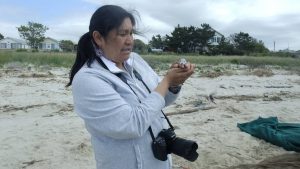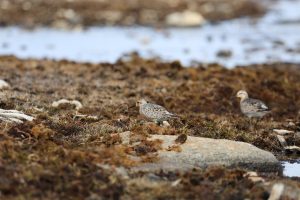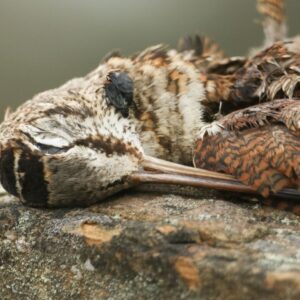BirdLife Report Sounds New Alarm for the Rufa Red Knot
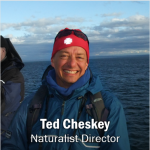 This post was written by Ted Cheskey, Naturalist Director at Nature Canada.
This post was written by Ted Cheskey, Naturalist Director at Nature Canada.
The feature image above was taken by Claudio Timm.
BirdLife International released a report recently about an alarming drop in numbers of the Endangered Species at its key stopover site at Tierra del Fuego at the tip of South America. The report revealed that January 2018 surveys of this area, led by Guy Morrison, renowned Canadian shorebird scientist and pioneer of shorebird conservation in the western hemisphere, found only 9,840 individuals, a 25% drop in the number of birds over the same period last year, and the lowest number ever recorded since the surveys began.
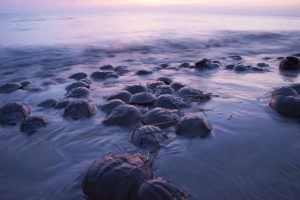
Horseshoe Crab, photo by Marc Peck.
It is speculated that the decline was driven by a bad year for Horseshoe Crab populations on the north Atlantic. Much of the Rufa Red Knot population migrates north in the month of May in a non-stop flight from Brazil to the Atlantic coast of the USA. Most birds take refuge on the beaches of Delaware Bay for a week or two, to take advantage of the billions of Horseshoe Crab eggs, freshly laid in the sands by female crabs emerging from the ocean, to restore their spent fat supplies, the fuel that powers their migration. In 2017, the crab numbers were low and the timing of their emergence delayed, meaning that there was less food at this key stopover when the migrating Knots needed it most. Many birds likely left Delaware Bay, en route to the Arctic with lower fat supplies, meaning that they arrived on their breeding grounds in the Canadian Arctic in a compromised state. The theory is that this compromised state results in lower reproductive output as the window for breeding is extremely short in the arctic and birds need to be in top health when they arrive on the breeding grounds to have a successful breeding season.
This plummet in the population of the Rufa Red Knot, related to Horseshoe Crab population fluctuations, was already noted in the early 2000s. Human harvest of the crabs, and possibly climate change are implicated as likely reasons for the decline. A small population, like that of the Rufa Red Knot is vulnerable to extinction, especially because of its dependence on a relatively small number of sites during its mammoth 30,000 km annual migration. Even when something negative happens to one site, most or all of the birds can be impacted. Recognizing, protecting and managing key stopover sites in favour of these birds is essential for their survival.
Here at Nature Canada we are trying to do our bit to help the Rufa Red Knot. For example, Nature Canada, with the support of the Commission on Environmental Cooperation, supports the Moose Cree First Nation’s efforts to nominate and recognize a Western Hemisphere Reserve Network Site within their homelands along James Bay. Southern James Bay is of tremendous importance to the Rufa Red Knot, especially for the flight south from the breeding grounds. There are no Horseshoe Crabs in James Bay, but there are tiny clams and other invertebrates on which the Knots and hundreds of thousands of other shorebirds feast. Rufa Red Knots stop over along James Bay by the thousands starting in late July with the adults followed by juveniles from mid August to early September. After fattening up, they continue on to the Gulf of St. Lawrence or the Atlantic coast of Canada and the USA, before flying over the Atlantic to the north coast of South America, on route to Tierra del Fuego.
The Moose Cree have become increasingly involved in shorebird conservation and monitoring since Lillian Trapper of the Moose Cree participated in WHSRN’s 25th anniversary celebration on Delaware Bay in 2011. As well as being one of the presenters at the official ceremony, Ms Trapper also participated in shorebird capture and banding on Delaware Bay, led by renowned Red Knot scientist and advocate Dr. Larry Niles. In the past few years, more Moose Cree have participated in summer shorebird camps on their homelands, organized by the Canadian Wildlife Service and in the spring at the Delaware Bay. This involvement is building local interest and capacity to monitor shorebirds and promote conservation and awareness within their Nation at this extremely important site for the Knot, which is also of extreme importance to geese and other waterfowl that are a staple in the local Cree diet. The Moose Cree’s interest and determination to ensure a healthy ecosystem for all wildlife and protect this and other areas in their homelands is inspiring.
Since 2012 Nature Canada has also worked to protect shorebirds in partnership with the Cree Nation Government, the Cree Nation of Waskaganish, the Cree Trappers Association and the Eeyou Marine Region Wildlife Board, in the Eeyou Istchee region (James Bay Cree – Quebec) of James Bay thanks to financial support from Environment Canada’s Habitat Stewardship program (HSP). We have succeeded in proving the importance for shorebirds and species at risk, including the Rufa Red Knot of Rupert Bay, of the southeastern side of James Bay, including the islands within the homelands of the Cree Nation of Waskaganish. Much of this area is part of a new candidate Important Bird and Biodiversity Area (IBA). To learn more about the importance of James Bay Cree homelands to shorebirds, check out this short Youtube video.

